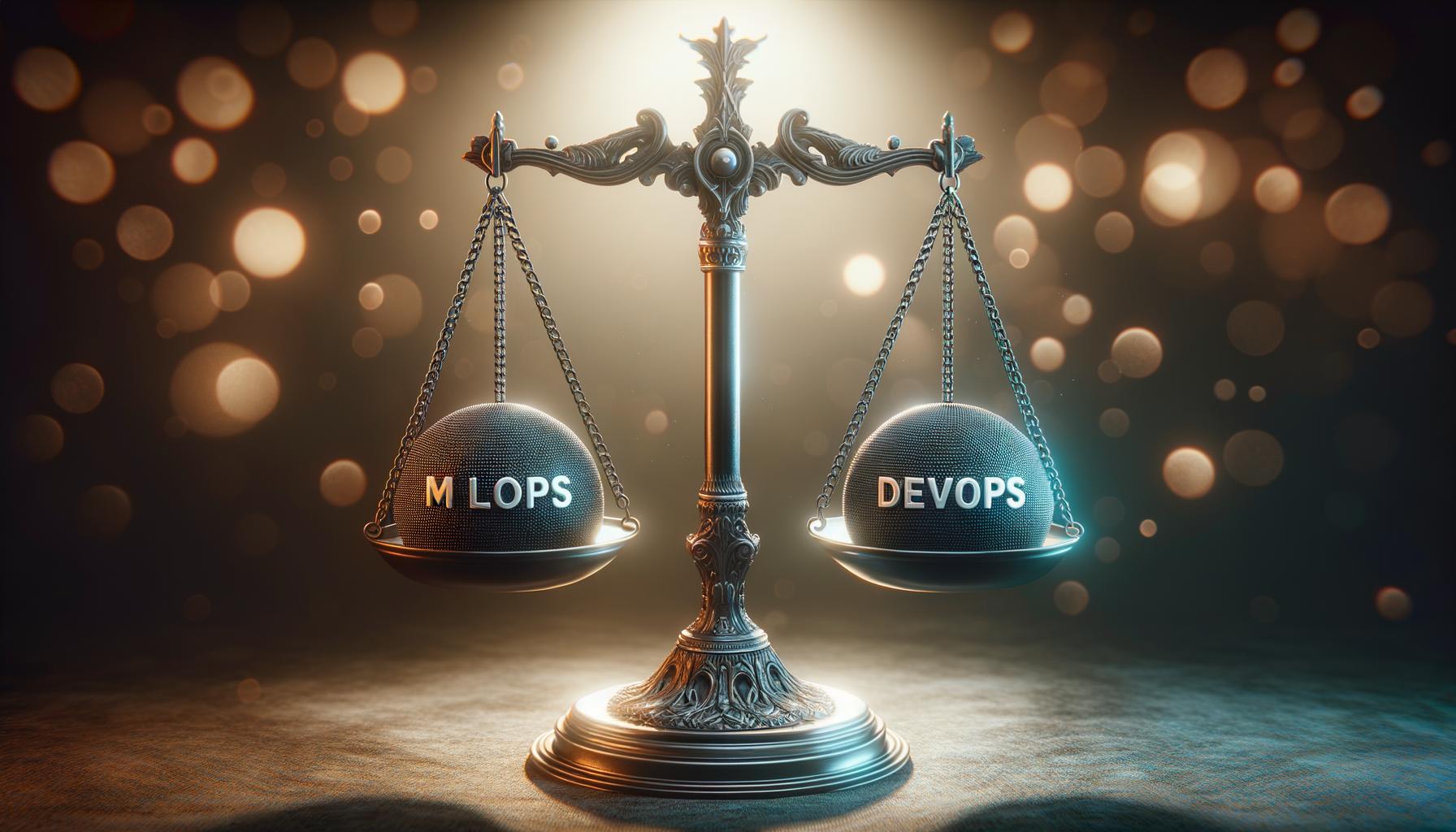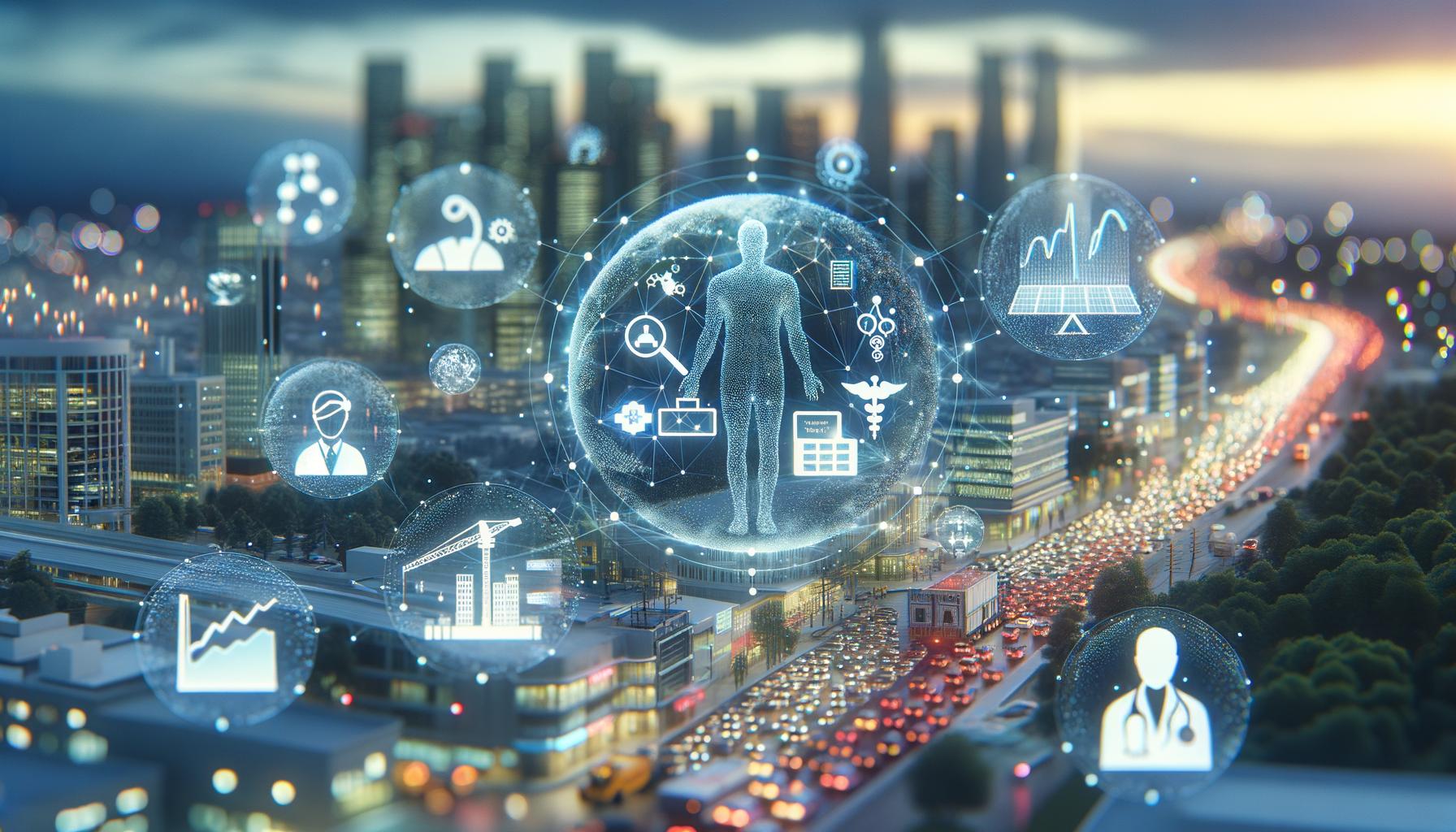Your Essential Guide to Understanding MLOps

As we push deeper into the nexus of technology and intelligence, machine learning has become an integral part of operations across industries, forming a complex yet rewarding field known as MLOps. But what is MLOps, you ask? Essentially, it represents the amalgamation of machine learning and operations, creating a unique ecosystem where these key tech disciplines thrive together. The significance of MLOps to modern tech industries can't be overstated, as it powers up efficiencies, forecasts trends, and bolsters decision-making processes. In this guide, we will not only delve into the intricacies of MLOps but also break down its key elements, mechanisms, and functions. Get ready to explore the history and evolution of MLOps, examine its principles and practices, and witness its real-world applications. From machine learning's role in MLOps and its differences with DevOps, to a comprehensive review of the tools and technologies that support it, we have it all covered. As we navigate this fascinating world of MLOps together, we aim to sculpt a broader understanding and appreciation of this rapidly growing field.
Understanding the MLOps Concept

MLOps represents a fusion of two pivotal disciplines - machine learning and operations - leading to a unique hybrid system. By leveraging the capabilities of machine learning, it employs automated systems to analyze, learn, and adapt from data patterns. Furthermore, it introduces operational efficiency through seamless execution, maintaining platform stability, and enabling continuous deployment of business models. This specific combination builds a unique ecosystem that inherently promotes automation, continuous improvement, and system stability, which are crucial components of any advanced technology setup, specifically in areas such as artificial intelligence and data analytics. For instance, tech giant Google has been leveraging MLOps to automate the deployment of machine learning models, thus saving significant time and resources.
At the heart of the MLOps concept is integration. Machine learning sets the scene for predictive analytics, enabling the system to make accurate forecasts based on historical and real-time data. In parallel, the operations facet ensures smooth and efficient execution of the designed systems. This symbiotic relationship enhances not just the technical performance, but also the business outcomes, making MLOps a powerful tool in modern technology-driven enterprises. As noted by a leading technology analyst at Forrester, "MLOps brings together the sophistication of predictive analysis and the efficiency of IT operations, making it an invaluable tool in today's digital world."
Why is MLOps Important?

MLOps, illustrating a pivotal amalgamation of machine learning and operations, holds a significant place in the dynamic landscape of modern technology industries. With the acceleration of artificial intelligence and machine learning innovations, businesses are challenged with scaling, managing, and deploying these complex models into production. This is where MLOps comes into play, creating a solid conduit that optimizes this transition by reducing the gap between the data science and operations team. Just as DevOps revolutionized software development, MLOps is revolutionizing how machine learning models are being developed and maintained. For example, companies like Uber and Airbnb have leveraged MLOps to automate their ML lifecycle, enabling them to build, test, and deploy models quickly and reliably. Beyond deployment, MLOps also monitors the health and performance of models in real-time, ensuring that they are always performing at their best. Therefore, in an era where data-driven insights are vital for competitive edge, the role of MLOps is incontrovertible, providing a robust framework for swift, efficient, and effective deployment, management, and monitoring of machine learning models in production environments.
Breaking Down "What is MLOps": An In-depth Look

Delving deeper into the realm of MLOps, you'll find that it's a subtle amalgamation of several elements that contribute to its function and purpose. It's akin to a well-oiled machine with interconnected parts, all designed to work together harmoniously. For starters, machine learning and operational expertise blend seamlessly. They make the core of MLOps, creating a unique discipline that weaves together significant aspects of tech innovation.
Furthermore, MLOps serves as the cornerstone for cutting-edge technology frameworks. Its mechanisms and functions permit a bi-directional integration of machine learning and operations. Not only does this harmonization expedite processes, but it also leads to the creation of improved algorithms and more accurate forecasting models, ensuring efficiency, precision, and stability.
Let's take the data versioning and continuous integration elements of MLOps for example. Never before considered in traditional machine learning methodologies, these elements have reshaped the whole process into a streamlined, automatic, and error-free flow. Automated testing and integration of revised components in a machine learning model have improved operational efficiency drastically.
Moreover, the flexibility inherent to MLOps ensures adaptation and scalability amidst changing requirements and scope of projects. The deployment of machine learning models to production, their monitoring, and associated management are simplified due to a structured, systematic model life cycle governed by MLOps.
In essence, MLOps conveys a sustainable bridge between the data science, engineering, and IT Operations teams. This collaborative environment brings the best from all sectors on a single platform, validating the saying, "The whole is greater than the sum of its parts." Truly, one can't help but marvel at how these unique symbiotic relationships within MLOps orchestrate a seamless operational output.
The History and Evolution of MLOps

The inception of MLOps stems from the intersection of DevOps, Data Engineering and Machine Learning, creating a fusion that has marked pivotal moments in the technological sphere. Its chronicle is notable, from its nascent, relatively simplistic applications to a now extensive and sophisticated framework that is revolutionizing industries. Simply put, MLOps is not merely a trend but a substantial transformation in how we approach machine learning workflows, building a lineage that indicates relentless progress and advancement.
As MLOps evolved, it became a fundamental accomplice in the revolutionizing of various industry sectors. Notable milestones in this journey include the transition from traditional manual model deployment to automation, which significantly increased efficiency and accuracy. This paradigmatic shift reduced errors associated with human intervention, revolutionizing the approach to machine learning operations and setting a new standard across industries.
The adoption of MLOps has been transformative, serving as an avant-garde mechanism for modern integration of operational procedures in machine learning. The rise of MLOps is wherein a seamless bridge between model development and operations was built, leading to faster and more streamlined production models. Such an evolutionary history affirms MLOps as a vital cog in the present and future realm of technology, embodying an unceasing tide of innovation that is shaping the future.
The Dynamics of MLOps: Key Principles and Practices

MLOps operates on a substantial set of principles that serve as the backbone for its smooth functioning. Renowned tech expert Michael Bowers aptly explains these, indicating that these principles involve continuous data validation, monitoring, and governance. He further explains the essence of maintaining data quality and security as a standard practice in MLOps.
However, to keep MLOps effective, following tried and tested execution techniques is as crucial as learning these principles. For instance, companies like Google and Amazon employ robust MLOps strategies like Automation and Collaboration. Automation accelerates many time-consuming tasks such as data validation and model tracking, therefore boosting efficiency. At the same time, collaboration enables team members to work synergistically on MLOps projects, sidestepping potential bottlenecks along the way.
Visibility is another essential practice in MLOps implementation. Andrew Ng, founder of DeepLearning.AI, underlines the need for transparency in the machine learning models, insisting that teams should track, review, and document all aspects of a project.
Alongside these practices, the Reproducibility principle is gaining traction too, as showcased by Netflix’s Metaflow framework. It allows data scientists to reproduce previous models and workflows, ensuring stability.
All these principles and practices form an intricate web, driving MLOps towards its objective. Understanding these dynamics equips any data professional or team to thrive in implementing MLOps.
The Role of Machine Learning in MLOps

Machine learning has a critical role in shaping and influencing MLOps, a process that unifies and synchronizes both machine learning and operations. In fact, it serves as the cornerstone around which all MLOps processes are built. Machine learning models, for example, need to be trained, tested, and then integrated into a system. The machine learning element provides the ability to analyze vast volumes of data, derive insights, and create data-driven decisions that are vital in today's tech industries. This leads to predictive modeling and the ability to forecast results that can drive business success.
MLOps leverages the power of machine learning by incorporating it into the entire tech operations process. It brings better alignment between data science and operations teams, thereby building a more unified approach to complex issues. For instance, Uber uses machine learning as a part of their MLOps process to predict demand, ensuring they always meet customer needs. So, the integration of machine learning essentially forms the backbone of MLOps, enabling it to enhance, innovate, and streamline a wide range of operational processes across various industries.
MLOps Vs. DevOps: Examining the Differences

MLOps and DevOps are both crucial processes in tech development, each boasting unique characteristics. DevOps, an established method, focuses on bridging gaps and enhancing collaboration between development and operations teams. Meanwhile, MLOps, the marriage of machine learning and operations, is a newer, specialized discipline emphasizing the integration of machine learning into operational workflows.
Each approach demonstrates distinctive abilities. DevOps is centered on speed, fostering seamless software development and deployment whilst maintaining system stability. In contrast, MLOps is designed specifically for the intricacies of machine learning systems and handles challenges such as model reproducibility, tracking, and versioning.
In practice, these differences are evident. For example, a typical successful DevOps project cultivates a culture of collaboration, enabling swift software iterations and releasing. On the other hand, an MLOps project may entail complex algorithm designs, effective data management, and the verification of model performance in production.
The implications of DevOps and MLOps are therefore diverse. DevOps streamlines software development promoting efficiency. However, MLOps holds transformative potential, capable of leveraging complex machine learning models and algorithms to drive technological advancement and innovation.
MLOps in Action: Real World Applications

MLOps has been employed in numerous real-world scenarios, showcasing its practicality and value. For instance, an online retail corporation used MLOps to optimize their product recommendation system. They integrated machine learning models with operations in a seamless way, leading to an increase in sales and customer satisfaction.
In the healthcare sector, MLOps is making significant transformations too. An excellent case is a renowned hospital that used machine learning models to forecast patient no-shows. MLOps ensured these models were efficiently integrated into their operation, resulting in lowered patient wait times and better resource allocation.
At a large financial institution, MLOps strategy was used to detect fraudulent transactions. Machine learning models were incorporated into day-to-day operations, helping to minimize revenue losses from fraud.
Furthermore, a global logistics company implemented MLOps for predicting shipment delays. Operationalizing machine learning models in this way significantly improved their logistics operations, reducing delays and enhancing customer satisfaction.
Each instance underscores how MLOps can create more efficient, accurate, and profitable operations. As these examples show, MLOps empowers companies across various sectors to leverage machine learning in operational processes effectively.
Tools and Technologies in MLOps

In implementing MLOps, several key tools and technologies emerge as crucial components. These essentials aid in creating efficient MLOps workflows. They range from certain software to specific programming languages and libraries, offering various functionalities within the MLOps ecosystem. Google Cloud's MLOps guide, for instance, highlights TensorFlow and Scikit-learn libraries for model development and experimentation.
Model validation tools like TensorFlow Extended (TFX) also play a critical role, providing reliable estimations of the model's performance in the real world. Kubeflow enables orchestration of machine learning pipelines on Kubernetes, empowering scalability and reproducibility, unlike more traditional methods. Continuous integration and continuous deployment (CI/CD) tools, including Jenkins or Spinnaker, facilitate efficient and reliable rollouts of models via validation and automated model deployment.
The standing examples underline the intertwined interplay of technology and tools within MLOps, each serving unique roles in aiding machine learning creation, deployment, and management. Their selection relies heavily on the projects’ specific needs, establishing the plasticity of tool selection in MLOps.
Understanding MLOps Lifecycle: From Model Building to Deployment

Within the realm of MLOps, a particular process comprises its life cycle; from blueprinting a model to its eventual deployment. As a linchpin to MLOps, model conception often originates from data scientists collaborating closely with stakeholders to address a specific problem or streamline operations. Post model creation, it undergoes a rigorous testing phase – including but not limited to cross-validation, bootstrapping, and A/B testing. This refines the model before it moves to the next phase.
Upon successful testing, the model then enters the crucial deployment phase. Here, it's integrated into pre-existing systems or applications to begin its work, marking the completion of the MLOps lifecycle. For example, Airbnb streamlined pricing suggestions by deploying a machine learning model, a clear testament to the potential of MLOps.
MLOps for Data Scientists: A New Era of Collaboration

MLOps has reinvented the operational terrain for data scientists, fostering an era of amplified cooperation. Previously, data scientists had to grapple with system complexities and manage resources while still grappling meet with their primary role requirements. However, MLOps has streamlined their tasks by addressing these issues, thus reducing the need to multitask.
MLOps enables automated testing and monitoring, ensuring accuracy and reliability in tasks typically undertaken by data scientists. By addressing tasks like model training, validation, and deployment, it allows data scientists to sharpen focus on complex problem-solving and strategic activities. With MLOps’ intervention, a synergy evolves where both the data scientist and the machine learn in unison.
Moreover, MLOps enhances resource utilization, taking devOps to the next level. By integrating version control systems into model development, it helps data scientists evade the challenges of overfitting and underfitting. This way, data scientists can better conserve resources for other critical functions.
Further ahead, data scientists employee MLOps for seamless collaboration with other teams, such as software developers. The continuous integration and delivery (CI/CD) practice of MLOps prompts greater inter-team efficiencies. It smoothes the hand-off of models to the software development teams, thereby expediting the overall development process.
The MLOps approach is a game-changer, revealing untapped potential in the data science sphere. As tech annotator TechTarget notes: "MLOps is more than a buzzword—it's a tectonic shift in IT operations that's helping data scientists drive unprecedented efficiencies and impact."
MLOps for Business: Advantages and Benefits

Implementing MLOps brings noticeable enhancements to business operations. For instance, it bolsters efficiency by streamlining the process of deploying, monitoring, and iterating machine learning models. This significantly reduces the time spent on repetitive tasks and ensures faster delivery of data-driven insights, crucial for decision-making.
Profitability also sees an impressive improvement with the inkling of MLOps. Optimization of resources and swift interpretation of data foster significant cost savings. With real-time insight delivery, companies can make quick decisions, propelling them ahead of their competition in the dynamic business landscape.
Adopting MLOps also encourages company-wide transparency. By bringing data scientists and operation experts together, companies enhance cross-departmental collaboration. This, in effect, results in a harmonious work environment where teams can understand each other's role better and respect the contributions made in achieving business objectives.
Above all, MLOps instills scalability. It creates a robust system that can handle high volumes of data and manage complex algorithms with ease. In the case of Netflix, MLOps played a crucial role in their recommendation system, which effectively scales to meet the demands of their vast user base.
Challenges in Implementing MLOps

MLOps implementation comes with its own set of difficulties. Organizations must navigate hurdles such as managing complex pipelines and ensuring optimal accuracy in machine learning models. Plus, striking the right balance between the rapid development needs of data scientists and the stringent operational requirements can further add to the complexity. Practical solutions, such as efficiently organizing and monitoring data pipelines or employing abundant testing to assure model accuracy, serve as viable solutions to these impediments.
Future Trends in MLOps
As we gaze ahead, MLOps shows promise in creating streamlined processes, through innovations like automated pipeline versioning and model monitoring. These advancements will likely blend seamlessly with the continuously evolving AI, fostering a more productive relationship between machine learning and operations.
Another emerging trend is the push for MLOps standards. Once established, these will assist organizations in effectively integrating MLOps, paving the way for broader acceptance. Imagine a future where every company, regardless of its size or sector, masters seamless ML operations.
Moreover, the rise of Explainable AI or XAI will likely impact MLOps. XAI focuses on interpretable models, an essential facet considering regulatory pressures and the need for trustworthy decisions. This aspect of MLOps is poised for much interest and growth.
Finally, MLOps will probably play a key role in narrowing the talent gap in machine learning. Enhancing collaboration among data scientists, ML engineers, and operations teams will yield better algorithm deployment, speeding up the ML production timeline. The future of MLOps indeed looks promising.
Conclusion: The Rise of MLOps in a Data-dominant World

In a world powered by data, the relevance of MLOps has surged, marking a significant shift in the tech industry. Its fusion of machine learning and operations has created a unique ecosystem, granting unprecedented operational efficiency to businesses and providing a new landscape for collaboration among data scientists. As we continue to unlock its potential, MLOps inevitably faces challenges, yet its trajectory promises to uphold the transformative values that shape its importance today.
